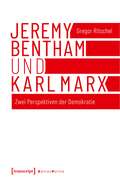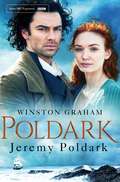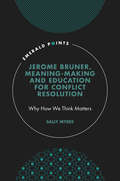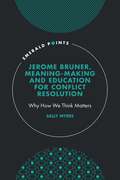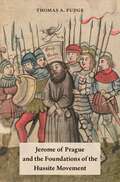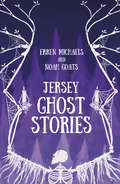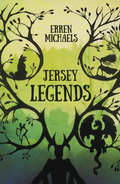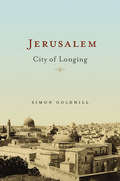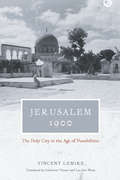- Table View
- List View
Jeremias Gotthelf - der "Dichter des Hauses": Die christliche Familie als literarisches Modell der Gesellschaft
by Werner HahlJeremy Bentham und Karl Marx: Zwei Perspektiven der Demokratie (Edition Politik #65)
by Gregor RitschelKarl Marx' (1818-1883) Polemiken gegen das »Genie bürgerlicher Dummheit« Jeremy Bentham (1748-1832) sind weithin bekannt. Gegenstand seiner strategischen Attacken war jedoch weniger die Person Bentham selbst, sondern vielmehr die bürgerliche Marktgläubigkeit der Zeit, zu dessen Stammvater er Bentham als »Urphilister« stilisierte. Jenseits seiner Polemik kam Marx aber tatsächlich zu einer ambivalenten Einschätzung von Benthams Utilitarismus. Beim systematischen Vergleich beider Autoren und deren Kritik an anti-demokratischen Zuständen deckt Gregor Ritschel viele gemeinsame Themen und Gedanken auf, die zusammengenommen eine neue, komplementäre Lesart zulassen.
Jeremy Poldark: A Novel Of Cornwall, 1790-1791 (Poldark #3)
by Winston GrahamJeremy Poldark is the third novel in Winston Graham's hugely popular Poldark series, which has become a television phenomenon starring Aidan Turner.Cornwall 1790. Ross Poldark faces the darkest hour of his life. Accused of wrecking two ships, he is to stand trial at the Bodmin Assizes. Despite their stormy married life, Demelza has tried to rally support for her husband. But there are enemies in plenty who would be happy to see Ross convicted, not least George Warleggan, the powerful banker, whose personal rivalry with Ross grows ever more intense.Jeremy Poldark is followed by the fourth book in this evocative series, Warleggan.
Jerome (The Early Church Fathers)
by Stefan RebenichAs a scholar, writer and ascetic, Jerome was a major intellectual force in the early Church and influenced the ideals of Christian chastity and poverty for many generations after his death. This book assembles a representative selection of his voluminous output. It will help readers to a balanced portrait of a complex and brilliant, but not always likeable man.
Jerome (The Early Church Fathers)
by Stefan RebenichAs a scholar, writer and ascetic, Jerome was a major intellectual force in the early Church and influenced the ideals of Christian chastity and poverty for many generations after his death. This book assembles a representative selection of his voluminous output. It will help readers to a balanced portrait of a complex and brilliant, but not always likeable man.
Jerome Bruner, Meaning-Making and Education for Conflict Resolution: Why How We Think Matters (Emerald Points)
by Sally MyersThe way we think about things matters just as much as what we think about things.This timely text investigates the work of educational philosopher and psychologist Jerome Bruner through the areas of knowledge representation, meaning-making, education and dispute. What people represent to others might not always be what they actually think. However, accepting this limitation, the aim of this book is to offer a means of examining representations about a given subject and an understanding of how those representations might change over time in response to learning, crisis, and encounter with 'other'.Myers offers an educational intervention that invites development of representations in response to difference. Presenting a new framework for examining controversy between worldviews and a method for creating space for difference, the book brings this into dialogue with education and research, conflict resolution and religion. This framework maps representations and proposes a method of engaging the psychological processes involved in changing representations.An excellent resource of interest to researchers, professionals and postgraduate students alike in education, sociology and philosophy related disciplines.
Jerome Bruner, Meaning-Making and Education for Conflict Resolution: Why How We Think Matters (Emerald Points)
by Sally MyersThe way we think about things matters just as much as what we think about things.This timely text investigates the work of educational philosopher and psychologist Jerome Bruner through the areas of knowledge representation, meaning-making, education and dispute. What people represent to others might not always be what they actually think. However, accepting this limitation, the aim of this book is to offer a means of examining representations about a given subject and an understanding of how those representations might change over time in response to learning, crisis, and encounter with 'other'.Myers offers an educational intervention that invites development of representations in response to difference. Presenting a new framework for examining controversy between worldviews and a method for creating space for difference, the book brings this into dialogue with education and research, conflict resolution and religion. This framework maps representations and proposes a method of engaging the psychological processes involved in changing representations.An excellent resource of interest to researchers, professionals and postgraduate students alike in education, sociology and philosophy related disciplines.
Jerome of Prague and the Foundations of the Hussite Movement
by Thomas A. FudgeThe life and work of Jerome of Prague have been overlooked outside Czech historiography, but represent an important chapter in the understanding of late medieval European history. Thomas A. Fudge makes a case for the central importance of Jerome, peer of Jan Hus, by reconstructing his biography using the original Latin and Czech sources and drawing significantly upon German, French, English, and Czech scholarship. The book traces the development of Jerome's life, paying special attention to the controversies he caused at the universities of Paris, Cologne, Heidelberg, Vienna, and Prague. Of particular note are the two heresy trials in which he was a defendant (Vienna 1410-12 and Constance 1415-16). Fudge situates Jerome within the philosophical conflicts of the late fourteenth and early fifteenth centuries. He argues that Jerome is not only an important component in the intellectual history of the Middle Ages, and a leading personality in the church's war on heresy, but is also an essential influence on the development of the Hussite movement in Bohemia. As the Italian humanist Poggio Bracciolini remarked, after hearing Jerome speak at the Council of Constance in 1416, "this was a man to remember." Jerome of Prague and the Foundations of the Hussite Movement brings to life a little known but indisputably significant figure of the late Middle Ages.
Jerome of Prague and the Foundations of the Hussite Movement
by Thomas A. FudgeThe life and work of Jerome of Prague have been overlooked outside Czech historiography, but represent an important chapter in the understanding of late medieval European history. Thomas A. Fudge makes a case for the central importance of Jerome, peer of Jan Hus, by reconstructing his biography using the original Latin and Czech sources and drawing significantly upon German, French, English, and Czech scholarship. The book traces the development of Jerome's life, paying special attention to the controversies he caused at the universities of Paris, Cologne, Heidelberg, Vienna, and Prague. Of particular note are the two heresy trials in which he was a defendant (Vienna 1410-12 and Constance 1415-16). Fudge situates Jerome within the philosophical conflicts of the late fourteenth and early fifteenth centuries. He argues that Jerome is not only an important component in the intellectual history of the Middle Ages, and a leading personality in the church's war on heresy, but is also an essential influence on the development of the Hussite movement in Bohemia. As the Italian humanist Poggio Bracciolini remarked, after hearing Jerome speak at the Council of Constance in 1416, "this was a man to remember." Jerome of Prague and the Foundations of the Hussite Movement brings to life a little known but indisputably significant figure of the late Middle Ages.
Jerome of Stridon: His Life, Writings and Legacy
by Josef LösslThis book assembles eighteen studies by internationally renowned scholars that epitomize the latest and best advances in research on the greatest polymath in Latin Christian antiquity, Jerome of Stridon (c.346-420) traditionally known as "Saint Jerome." It is divided into three sections which explore topics such as the underlying motivations behind Jerome's work as a hagiographer, letter-writer, theological controversialist, translator and exegete of the Bible, his linguistic competence in Greek, Hebrew, and Syriac, his relations to contemporary Jews and Judaism as well as to the Greek and Latin patristic traditions, and his reception in both the East and West in late antiquity down through the Protestant Reformation. Familiar debates are re-opened, hitherto uncharted terrain is explored, and problems old and new are posed and solved with the use of innovative methodologies. This monumental volume is an indispensable resource not only for specialists on Jerome but also for students and scholars who cultivate interests broadly in the history, religion, society, and literature of the late antique Christian world.
Jerome of Stridon: His Life, Writings and Legacy
by Josef LösslThis book assembles eighteen studies by internationally renowned scholars that epitomize the latest and best advances in research on the greatest polymath in Latin Christian antiquity, Jerome of Stridon (c.346-420) traditionally known as "Saint Jerome." It is divided into three sections which explore topics such as the underlying motivations behind Jerome's work as a hagiographer, letter-writer, theological controversialist, translator and exegete of the Bible, his linguistic competence in Greek, Hebrew, and Syriac, his relations to contemporary Jews and Judaism as well as to the Greek and Latin patristic traditions, and his reception in both the East and West in late antiquity down through the Protestant Reformation. Familiar debates are re-opened, hitherto uncharted terrain is explored, and problems old and new are posed and solved with the use of innovative methodologies. This monumental volume is an indispensable resource not only for specialists on Jerome but also for students and scholars who cultivate interests broadly in the history, religion, society, and literature of the late antique Christian world.
Jerry on Jerry: The Unpublished Jerry Garcia Interviews
by Trixie Garcia Dennis McNallyThese never-before-published interviews with Jerry Garcia reveal his thoughts on religion, politics, his personal life, and his creative process. Jerry on Jerry provides new insight into the beloved frontman of the Grateful Dead in time for the 50th Anniversary of the band.Released by the Jerry Garcia Family and made available to the public for the first time, these are some of the most candid, intimate interviews with Jerry Garcia ever published. Here, Garcia speaks openly about everything from growing up in the San Francisco Bay Area and his first encounters with early R&B to his thoughts on songwriting, LSD, the Beats and Neal Cassady, government, movies, and more. Illustrated with family photographs, ephemera, and Jerry's artwork, Jerry on Jerry presents uniquely poignant, unguarded, and astute moments, showing a side of Jerry that even his biggest fans have not known.
Jersey Ghost Stories
by Erren Michaels Noah GoatsStep away from sunny Jersey’s present day and into the sinister shadows of the past … the island’s history is filled with dark deeds and restless spirits. Collected here for the first time are stories that have endured through centuries to chill the blood. This unique anthology gathers together the most famous tales, such as the Ghost Bride and the White Lady, along with lesser-known tales, such as The Lake. Erren Michaels’ and Noah Goats’ skilful storytelling, along with Ryan Thomas’ detailed illustrations, beautifully combine to relate these haunting tales of murder and vengeance that refuse to be forgotten.
Jerusalem (Routledge Revivals)
by Henry CattanFirst published in 1981, Jerusalem provides an overview of the history of Jerusalem and its crucial linkage with the peace and stability in the Middle East. Jerusalem is unique amongst all the cities of the world because of its association with three great religions. It is the spiritual and religious heritage to one half of humanity and is holy for millions of Christians, Jews, and Muslims. All three religion have a vital interest in preserving in addition to their Holy places and sanctuaries, the living presence of the adherents to their faith in the Holy City. When the Zionist movement was formed at the end of the last century, the idea of a Jewish State was conceived as an answer to anti-semitism, and the movement initially considered other countries for settlement because Jerusalem was seen as a spiritual rather than a secular home to the Jewish people. Yet since the creation of the state of Israel in 1948, Zionism has claimed Jerusalem as its own. It is obvious that neither the Palestinians, not the Arabs, nor Islam and Christianity will acquiesce in Israeli domination. This book argues that the continuation of Zionism in its present form is likely to prove perilous to peace and stability in the region. This book is an important historical read for students and scholars of Middle East studies and Middle East history.
Jerusalem (Routledge Revivals)
by Henry CattanFirst published in 1981, Jerusalem provides an overview of the history of Jerusalem and its crucial linkage with the peace and stability in the Middle East. Jerusalem is unique amongst all the cities of the world because of its association with three great religions. It is the spiritual and religious heritage to one half of humanity and is holy for millions of Christians, Jews, and Muslims. All three religion have a vital interest in preserving in addition to their Holy places and sanctuaries, the living presence of the adherents to their faith in the Holy City. When the Zionist movement was formed at the end of the last century, the idea of a Jewish State was conceived as an answer to anti-semitism, and the movement initially considered other countries for settlement because Jerusalem was seen as a spiritual rather than a secular home to the Jewish people. Yet since the creation of the state of Israel in 1948, Zionism has claimed Jerusalem as its own. It is obvious that neither the Palestinians, not the Arabs, nor Islam and Christianity will acquiesce in Israeli domination. This book argues that the continuation of Zionism in its present form is likely to prove perilous to peace and stability in the region. This book is an important historical read for students and scholars of Middle East studies and Middle East history.
Jerusalem: City of Longing (Jerusalem Studies In Religion And Culture Ser. #24)
by Simon GoldhillJerusalem is the site of some of the most famous religious monuments in the world, from the Dome of the Rock to the Church of the Holy Sepulchre to the Western Wall of the Temple. Since the nineteenth century, the city has been a premier tourist destination, not least because of the countless religious pilgrims from the three Abrahamic faiths. But Jerusalem is more than a tourist site—it is a city where every square mile is layered with historical significance, religious intensity, and extraordinary stories. It is a city rebuilt by each ruling Empire in its own way: the Jews, the Romans, the Christians, the Muslims, and for the past sixty years, the modern Israelis. What makes Jerusalem so unique is the heady mix, in one place, of centuries of passion and scandal, kingdom-threatening wars and petty squabbles, architectural magnificence and bizarre relics, spiritual longing and political cruelty. It is a history marked by three great forces: religion, war, and monumentality. In this book, Simon Goldhill takes on this peculiar archaeology of human imagination, hope, and disaster to provide a tour through the history of this most image-filled and ideology-laden city—from the bedrock of the Old City to the towering roofs of the Holy Sepulchre. Along the way, we discover through layers of buried and exposed memories—the long history, the forgotten stories, and the lesser-known aspects of contemporary politics that continue to make Jerusalem one of the most embattled cities in the world.
Jerusalem: City of the Book
by Merav Mack Benjamin BalintA captivating journey through the hidden libraries of Jerusalem, where some of the world’s most enduring ideas were put into words In this enthralling book, Merav Mack and Benjamin Balint explore Jerusalem’s libraries to tell the story of this city as a place where some of the world’s most enduring ideas were put into words. The writers of Jerusalem, although renowned the world over, are not usually thought of as a distinct school; their stories as Jerusalemites have never before been woven into a single narrative. Nor have the stories of the custodians, past and present, who safeguard Jerusalem’s literary legacies. By showing how Jerusalem has been imagined by its writers and shelved by its librarians, Mack and Balint tell the untold history of how the peoples of the book have populated the city with texts. In their hands, Jerusalem itself—perched between East and West, antiquity and modernity, violence and piety—comes alive as a kind of labyrinthine library.
Jerusalem: From the Ottomans to the British (Library of Middle East History)
by Roberto MazzaLed by General Allenby, British troops entered Jerusalem in December 1917, thereby ending Ottoman rule and opening a new and important era in the history of Jerusalem. This historical moment has often been described as the beginning of a period of great change and transformation, depicting the British as the real modernisers of Jerusalem. In this study, Mazza does not offer just another history of Jerusalem. He focuses on the often neglected transition from Ottoman rule to British administration, examining the impact of the First World War and considering the socio-political changes which occurred as a result of the transition. He also considers the impact of these changes on the local population and how they, in turn, could act as agents of change in this formative period. He discusses the role of the British in Jerusalem as well as reactions to the occupation in Britain. Through the extensive use of case studies and unpublished archival material from Spain and Vatican archives, Mazza takes a fresh approach to this period of Jerusalem's history; focusing on a previously overlooked area and opening the field to new perspectives and research.
Jerusalem: The Biography – A History of the Middle East (Litterature & Documents Ser.)
by Simon Sebag MontefioreThoroughly updated and revised for 2024, JERUSALEM: THE BIOGRAPHY is the history of the Middle East through the lens of the Holy City and the Holy Land, from King David to the wars and chaos of today. The history of Jerusalem is the story of the world: Jerusalem is the universal city, the capital of two peoples, the shrine of three faiths. The Holy City and Holy Land are the battlefields for today's multifaceted conflicts and, for believers, the setting for Judgement Day and the Apocalypse.How did this small, remote town become the Holy City, the 'centre of the world' and now the key to peace in the Middle East? Why is the Holy Land so important not just to the region and its many new players, but to the wider world too? Drawing on new archives and a lifetime's study, Montefiore reveals this ever-changing city and turbulent region through the wars, love affairs and revelations of the kings, empresses, amirs, sultans, caliphs, presidents, autocrats, imperialists and warlords, poets, prophets, saints and rabbis, conquerors and whores who created, destroyed, chronicled, and believed in Jerusalem and the Holy Land. A classic of modern literature, this is not only the epic story of 3,000 years of faith, slaughter, fanaticism, co-existence, power and myth, but also a freshly updated, carefully balanced history of the Middle East, from King David to the new players and powers of the twenty-first century, from the birth of Judaism, Christianity and Islam to the Israel-Palestine conflict and the mayhem of today.This is how today's Middle East was forged, how the Holy Land became sacred and how Jerusalem became Jerusalem - the only city that exists twice - in heaven and on earth.
Jerusalem: The Holy City in the Eyes of Chroniclers, Visitors, Pilgrims, and Prophets from the Days of Abraham to the Beginnings of Modern Times
by F. E. PetersThis remarkable portrayal of Jerusalem has become a favorite of many readers interested in this city's dramatic past. Through a collection of firsthand accounts, we see Jerusalem as it appeared through the centuries to a fascinating variety of observers--Jews, Christians, Muslims, and secularists, from pilgrim to warrior to merchant. F. E. Peters skillfully unites these moving eyewitness statements in an immensely readable narrative commentary.Originally published in 1995.The Princeton Legacy Library uses the latest print-on-demand technology to again make available previously out-of-print books from the distinguished backlist of Princeton University Press. These editions preserve the original texts of these important books while presenting them in durable paperback and hardcover editions. The goal of the Princeton Legacy Library is to vastly increase access to the rich scholarly heritage found in the thousands of books published by Princeton University Press since its founding in 1905.
Jerusalem: A Brief History (Wiley Blackwell Brief Histories of Religion #32)
by Michael ZankProvides a short, accessible, and lively introduction to Jerusalem Jerusalem - A Brief History shows how Jewish, Christian, and Islamic scriptures confer providential meaning to the fate of the city and how modern Jerusalem is haunted by waves of biblical fantasy aiming at mutually exclusive status-quo rectification. It presents the major epochs of the history of Jerusalem’s urban transformation, inviting readers to imagine Jerusalem as a city that is not just sacred to the many groups of people who hold it dear, but as a united, unharmed place that is, in this sense, holy. Jerusalem - A Brief History starts in modern Jerusalem—giving readers a look at the city as it exists today. It goes on to tell of its emergence as a holy city in three different ways, focusing each time on another aspect of the biblical past. Next, it discusses the transformation of Jerusalem from a formerly Jewish temple city, condemned to oblivion by its Roman destroyers, into an imperially sponsored Christian theme park, and the afterlife of that same city under later Byzantine and Muslim rulers. Lastly, the book returns to present day Jerusalem to examine the development of the modern city under the Ottomans and the British, the history of division and reunification, and the ongoing jostling over access to, and sovereignty over, Jerusalem’s contested holy places. Offers a unique integration of approaches, including urban history, the rhetoric of power, the history of art and architecture, biblical hermeneutics, and modern Middle Eastern Studies Places great emphasis on how Jerusalem is a real city where different people live and coexist Examines the urban transformation that has taken place since late Ottoman times Utilizes numerous line drawings to demonstrate how its monumental buildings, created to illustrate an alliance of divine and human power, are in fact quite ephemeral, transient, and fragile Jerusalem - A Brief History is a comprehensive and thoughtful introduction to the Holy City that will appeal to any student of religion and/or history.
Jerusalem: A Brief History (Wiley Blackwell Brief Histories of Religion)
by Michael ZankProvides a short, accessible, and lively introduction to Jerusalem Jerusalem - A Brief History shows how Jewish, Christian, and Islamic scriptures confer providential meaning to the fate of the city and how modern Jerusalem is haunted by waves of biblical fantasy aiming at mutually exclusive status-quo rectification. It presents the major epochs of the history of Jerusalem’s urban transformation, inviting readers to imagine Jerusalem as a city that is not just sacred to the many groups of people who hold it dear, but as a united, unharmed place that is, in this sense, holy. Jerusalem - A Brief History starts in modern Jerusalem—giving readers a look at the city as it exists today. It goes on to tell of its emergence as a holy city in three different ways, focusing each time on another aspect of the biblical past. Next, it discusses the transformation of Jerusalem from a formerly Jewish temple city, condemned to oblivion by its Roman destroyers, into an imperially sponsored Christian theme park, and the afterlife of that same city under later Byzantine and Muslim rulers. Lastly, the book returns to present day Jerusalem to examine the development of the modern city under the Ottomans and the British, the history of division and reunification, and the ongoing jostling over access to, and sovereignty over, Jerusalem’s contested holy places. Offers a unique integration of approaches, including urban history, the rhetoric of power, the history of art and architecture, biblical hermeneutics, and modern Middle Eastern Studies Places great emphasis on how Jerusalem is a real city where different people live and coexist Examines the urban transformation that has taken place since late Ottoman times Utilizes numerous line drawings to demonstrate how its monumental buildings, created to illustrate an alliance of divine and human power, are in fact quite ephemeral, transient, and fragile Jerusalem - A Brief History is a comprehensive and thoughtful introduction to the Holy City that will appeal to any student of religion and/or history.
Jerusalem 1900: The Holy City in the Age of Possibilities
by Vincent LemirePerhaps the most contested patch of earth in the world, Jerusalem’s Old City experiences consistent violent unrest between Israeli and Palestinian residents, with seemingly no end in sight. Today, Jerusalem’s endless cycle of riots and arrests appears intractable—even unavoidable—and it looks unlikely that harmony will ever be achieved in the city. But with Jerusalem 1900, historian Vincent Lemire shows us that it wasn’t always that way, undoing the familiar notion of Jerusalem as a lost cause and revealing a unique moment in history when a more peaceful future seemed possible. In this masterly history, Lemire uses newly opened archives to explore how Jerusalem’s elite residents of differing faiths cooperated through an intercommunity municipal council they created in the mid-1860s to administer the affairs of all inhabitants and improve their shared city. These residents embraced a spirit of modern urbanism and cultivated a civic identity that transcended religion and reflected the relatively secular and cosmopolitan way of life of Jerusalem at the time. These few years would turn out to be a tipping point in the city’s history—a pivotal moment when the horizon of possibility was still open, before the council broke up in 1934, under British rule, into separate Jewish and Arab factions. Uncovering this often overlooked diplomatic period, Lemire reveals that the struggle over Jerusalem was not historically inevitable—and therefore is not necessarily intractable. Jerusalem 1900 sheds light on how the Holy City once functioned peacefully and illustrates how it might one day do so again.


